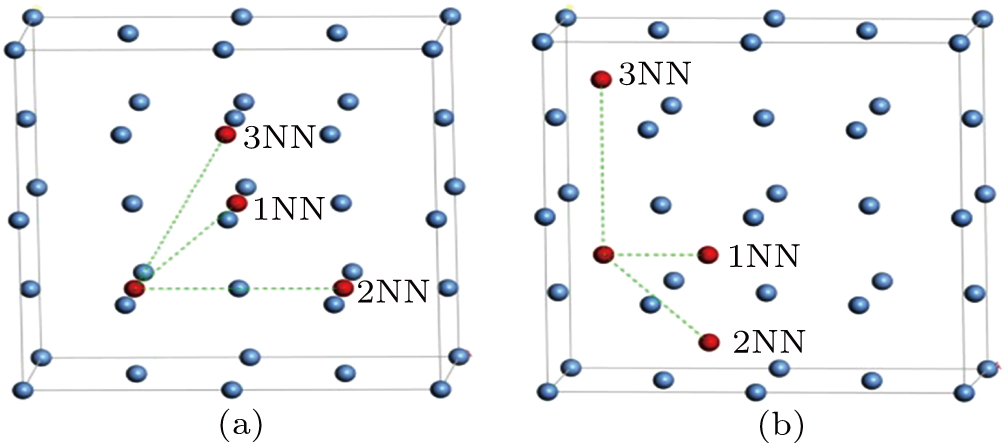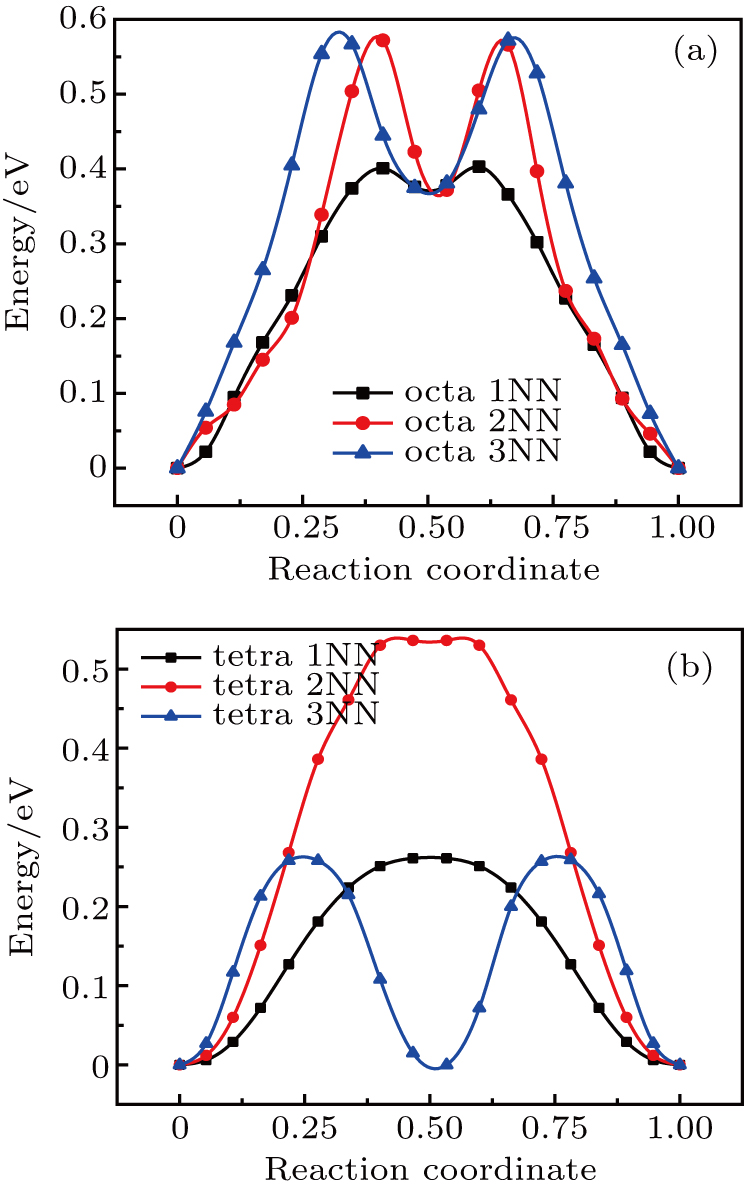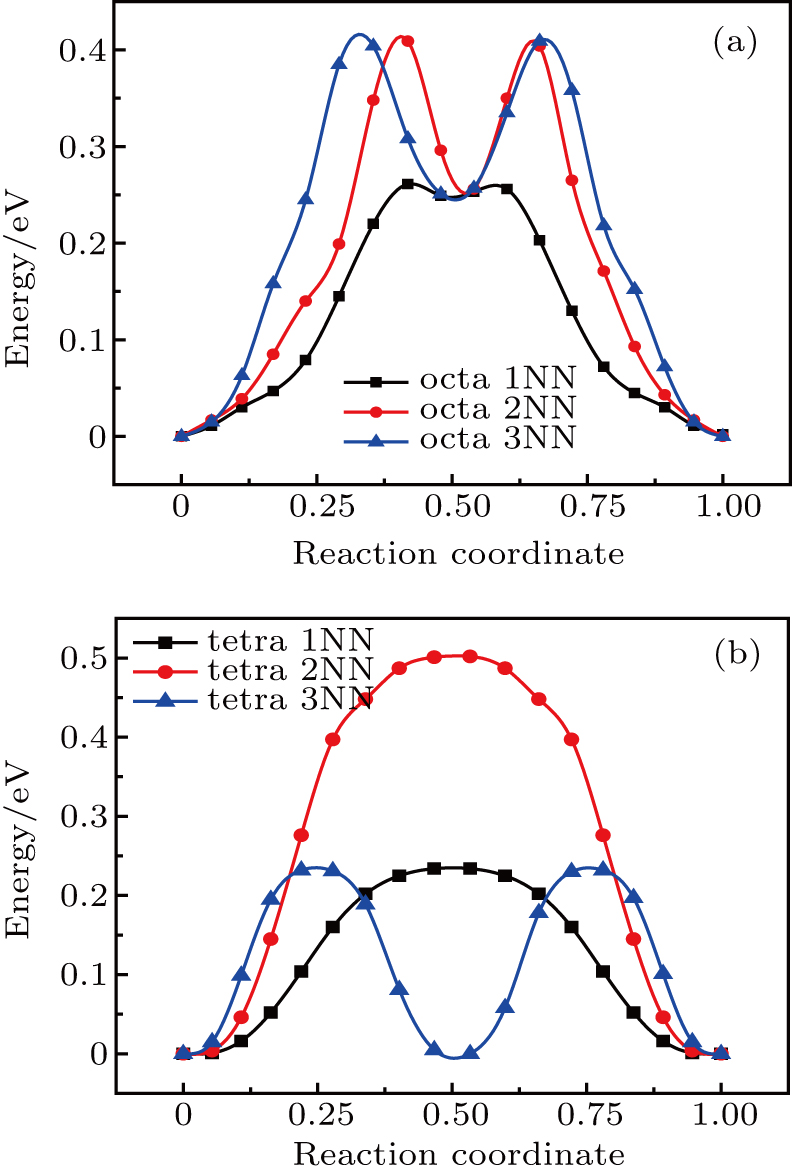† Corresponding author. E-mail:
To reveal the potential aging mechanism for self-irradiation in Pu–Ga alloy, we choose Au–Ag alloy as its substitutional material in terms of its mass density and lattice structure. As a first step for understanding the microscopic behavior of point defects in Au–Ag alloy, we perform a molecular dynamics (MD) simulation on energetics and diffusion of point defects in Au and Ag metal. Our results indicate that the octahedral self-interstitial atom (SIA) is more stable than the tetrahedral SIA. The stability sequence of point defects for He atom in Au/Ag is: substitutional site 


Over the past few years, we have witnessed great progress of nucleation and growth mechanisms for He behavior in Pu-based materials, in particular pure δ phase Pu and Pu–Ga alloy.[1–9] As a radioactive nuclide, Pu α decay would produce various defects, such as He interstitial atom, self-interstitial atom (SIA), and vacancy, result in a collision displacement cascade, and disrupt the physical, chemical and mechanical properties of Pu-based system. Therefore, the self-irradiation effect, in particular He–V (V denotes vacancy) cluster, would be useful for revealing the aging mechanisms in Pu-based materials. However, we have not yet completely understood the self-irradiation effect in Pu material, in particular the aggregation of He atoms, the nucleation and growth of He–vacancy cluster and/or He bubble, which still need further investigation.[10] Recently, many research groups[11–14] have done a lot of excellent work on the electronic, magnetic and structural properties of metallic Pu and its alloys, 5f itinerant/localized behavior, superconductivity and collision displacement cascade induced by self-irradiation in Pu-based materials by using multi-scale simulation technique, such as first principle, molecular dynamics and kinetic Monte Carlo. However, the low symmetry for ground state of metallic Pu (i.e., α phase Pu), the relativistic effect resulting from high atomic number of Pu and the strongly correlated effect arising from the partially filled Pu 5f orbitals pose a considerable challenge for condensed matter physics.
In fact, the theoretical research on the physical, chemical and mechanical properties of He atom in δ-Pu is very difficult to perform due to the δ-Pu having chemical activity, toxicity, radioactivity, complex 5f occupation, and metastable phase stability, which is extremely sensitive to temperature, pressure and chemical doping. Therefore, experimental observation and/or numerical simulation on a substitution material for Pu–Ga alloy can be a feasible approach. In principle, self-irradiation effect induced by 239Pu α decay is dependent on the lattice structure and mass density, thus we consider Au–Ag alloy (fcc structure) to be an apposite substitution for Pu–Ga alloy (fcc structure). In this respect, the physical properties, point defect properties and He behavior in Au–Ag alloy can be useful for understanding the He behavior in Pu–Ga alloy. Stevens et al.[15] have used a transmission electron microscope (TEM) to investigate the nucleation and growth of He defects in Au–Ag alloy, and found that He bubbles are non-uniformly distributed across the crystal lattice, and the nucleation of He bubble might not be related to He irradiation in Au–Ag alloy. For He behavior in Au–Ag alloy, Thomé et al.[16] have investigated the radiation damage to He implanted Au-based alloy (Au3Ag2) by using the positron annihilation spectrum (PAS) technique. Their results indicate that a fundamental reason for the degradation of Au3Ag2 alloy is pressure increase resulting from the nucleation and growth of He bubble. Zhu[17] has studied the typical point defects in Au–Ag alloy, such as He atom interstice, vacancy and its cluster, by using the density functional theory (DFT), and evaluated the formation energy for He atom in individual defect sites. These results show that the relative stability of point defects and the formation energy for He in Au–Ag alloy are closely related to the atomic configuration of host atom in the vicinity of defect site and mass density.
To our knowledge, although some research groups have employed first principles calculation within the framework of DFT to study the physical properties of Au–Ag alloy and the microscopic behaviors of He defects, few reports have paid attention to the molecular dynamics (MD) simulation[18–22] for He behavior in Au–Ag alloy. In this work, we employ MD method on basis of embedded atom method (EAM) to analyze the physical properties and He behaviors in Au and Ag metal, which can be useful for understanding He point defects in Au–Ag alloy, even δ phase Pu–Ga alloy. As mentioned earlier, experimental work poses a huge challenge due to the special character of Pu-based system, so we plan to perform an MD simulation on alternative candidate for δ phase Pu–Ga alloy (i.e., Au–Ag alloy) in a future work.
Face-centered cubic (fcc) metal usually possesses a tetrahedral interstitial site comprised of four atoms, an octahedral interstitial site made up of six atoms, and a substitutional site originating from an impurity atom replacement of a host atom. To estimate the formation energy for point defects, we first construct a 
For an initial configuration, the temperature slowly increases to 300 K during 5×105 steps in the NVT ensemble; the time step is set to be 0.5 fs. An interstitial atom is added to a defective site when temperature reaches 300 K, the system is then completely relaxed through isothermal process of 5000 steps in the NPT ensemble. Next, the system slowly cools down to 1×10−4 K during 5×104 steps in the NVT ensemble. Finally, we obtain an energetically optimal configuration including the point defects.
In the MD simulation, we use Au, Ag, and Au–Ag embedded atom model (EAM) potentials of Zhou et al.[23,24] and He–He potential of Valone et al.[25] For Au–He and Ag–He cross potentials, we perform a first principles calculation on a hypothetical Au3He/Ag3He crystal (L12 lattice structure) within space group of 
 |
 |
 |
The first principles calculations are implemented by density functional theory through using all-electron full potential linearized augmented plane wave (FP-LAPW) method within the framework of WIEN2K code.[27–29] The exchange–correlation energy is approximated with Perdew–Burke–Ernzerhof (PBE)[30] form of generalized gradient approximation (GGA). The maximum l value for partial waves used inside the muffin-tin (MT) sphere is lmax = 10. The cutoff parameter is Rmt×Kmax = 9. In the interstitial region, the charge density and the potential are expanded into a Fourier series with wave vectors up to Gmax = 12 a.u.−1. The MT radius values are set to be 2.00 Bohr, 2.00 Bohr, and 1.60 Bohr for Au, Ag, and He atoms, respectively. Optimized lattice constants for Au3He and Ag3He are 4.0671 Å and 4.1256 Å. The modified EAM (MEAM) potential parameters for Au–He and Ag–He are shown in Table
| Table 1.
MEAM potential parameters for Au–He and Ag–He interatomic potential. MEAM parameters for cross potential. Parameters are for a fit to a Rose curve. . |
For the formation energy of 




Self-interstitial atom (SIA) is an elementary point defect in crystal lattice, in which a host atom occupies an interstitial site. Formation energy is a criterion for structural stability of impurity doping and/or chemical reaction in metallic material. Thus the formation energy of SIA can be used to understand the structural properties of point defect. Formation energy of SIA is given by
 |
Similarly, the formation energy of He interstitial site is given by
 |
Substitutional defect for He atom represents the point defect configuration of one He atom combining with one vacancy in lattice, and reads,
 |
In addition, the formation energy of 
 |





In this work, we adopt nudged elastic band (NEB) method to calculate the migration energy for point defect diffusion at ambient temperature. In this method, several intermediate transition states between initial and final sites for atomic diffusion should be introduced. Diffusion atom can occupy a space site with a lower energy during diffusion procedure under elastic tension, automatically diffuse into these sites, and forms the so-called minimum energy path (MEP). Migration energy of atomic diffusion can be obtained by subtracting the total energy of initial site from the total energy of saddle point on the MEP[24]
 |
Migration energy for point defect diffusion at high temperature is calculated through the effective diffusion coefficient Deff, which is given by
 |
According to the diffusion law of Einstein, Dsim is defined as
 |
Atomic mean square displacement (MSD) is given by
 |
 |
By substituting Eq. (
 |
Based on classical transition state theory, Deff can be given by an approximate expression:
 |
For the atomic effective diffusion coefficient in Au and Ag metal, we construct a 

For the formation energy values of different defect sites in Au and Ag metal, MD simulation results are summarized in Table
| Table 2.
Formation energy values (in unit eV) of self-interstitial atom (SIA) in Au and Ag metals. |
In principle, the formation energy of point defect for single He atom is a fundamental characteristic for evaluating its behavior in material matrix. We mainly consider two point defect structures in Au and Ag in this work; i.e., single He atom occupying interstitial and substitution sites, respectively. The formation energy values of He atom occupying interstitial and substitutional sites in Au and Ag metals are summarized in Table
| Table 3.
Formation energy values (in unit eV) of He atom occupying interstitial and substitutional sites in Au and Ag metals, respectively. |
As shown in Table 

As mentioned earlier, a He atom arising from the internal or external factors, such as α decay induced by self-irradiation and/or He implantation, prefers to combine with the surrounding vacancy defect due to its insolubility in material matrix, then produces the He–vacancy complex, i.e., He–V cluster, and finally results in the nucleation, accumulation and growth of He bubble. In principle, 


 | Fig. 2. Plots of formation energy of 
|
 | Fig. 3. Plots of formation energy of 
|
As shown in Figs. 


As mentioned earlier, He readily occupies a defect site with a larger volume in fcc Au/Ag since the electron density of host atom with larger spacial volume is lower, and these electrons do not bond with other orbital electrons from the surrounding atoms. Therefore, the He atom readily combines with vacancy and its cluster, and produces 







For three typical point defects in metallic Au and Ag including vacancy, SIA, and He interstitial atom at ambient temperature, we employ the nudged elastic band method (NEB) to estimate the migration energy values for these three defects diffusing into 1NN, 2NN, and 3NN sites, respectively, and analyze the diffusion property and mechanism for each of these point defects. An interstitial atom occupying the octahedral site and an interstitial atom occupying the tetrahedral site diffusing into their corresponding neighboring sites are shown in Figs.
 | Fig. 4. Schematic diagrams for interstitial atom diffusing into neighboring sites: (a) octahedral interstitial site in fcc Au and (b) tetrahedral interstitial site in fcc Au metal. |
Figures
 | Fig. 5. Plots of total energy versus reaction coordinate for mono-vacancy diffusing into its 1NN, 2NN, and 3NN in (a) Au and (b) Ag metal. |
| Table 4.
Migration energy values (in unit eV) of mono-vacancy diffusing into its 1NN, 2NN, and 3NN in Au and Ag metals. Em (iNN) (i = 1, 2, 3) refer to migration energy of mono-vacancy diffusing into its i-th nearest neighbor. . |
As shown in Table
For the fcc Au and Ag crystal, we consider two typical defect structures for self-interstitial atom (SIA), i.e., the octahedral and tetrahedral site, and estimate the migration energy values of SIA located in these two defect sites diffusing into its 1NN, 2NN, and 3NN sites. The plots of total energy versus reaction coordinate for SIA along its diffusion path are shown in Figs.
 | Fig. 6. Plots of total energy versus reaction coordinate for (a) octahedral and (b) tetrahedral SIAs diffusing into its 1NN, 2NN, and 3NN sites in Au metal. |
 | Fig. 7. Plots of total energy versus reaction coordinate for (a) octahedral and (b) tetrahedral SIAs diffusing into its 1NN, 2NN, and 3NN sites in Ag metal. |
| Table 5.
Migration energy values (in unit eV) of the octahedral and tetrahedral SIAs diffusing into its 1NN, 2NN, and 3NN in Au and Ag metals. Em (octa) and Em (tetra) are migration energy of the octahedral and tetrahedral SIAs diffusing into their corresponding neighboring sites, respectively. . |
The migration energy for SIA (Table
Figures
The plots of the total energy versus reaction coordinate for 1NN, 2NN, and 3NN diffusion for He interstitial atom in Au and Ag metal, estimated with NEB method, are shown in Figs.
 | Fig. 8. Plots of total energy reaction coordinate for (a) octahedral and (b) tetrahedral He interstitial atom diffusing into their corresponding neighboring sites in Au metal. |
 | Fig. 9. Plots of total energy versus reaction coordinate for (a) octahedral and (b) tetrahedral He interstitial atom diffusing into their corresponding neighboring sites in Ag metal. |
| Table 6.
Migration energy values (in unit eV) of 1NN, 2NN, and 3NN diffusion for He interstitial atom in Au and Ag metals. Em (octa) and Em (tetra) are migration energy value of octahedral and tetrahedral He interstitial atoms diffusing into their corresponding neighboring sites, respectively. . |
As shown in Figs.
To further understand the diffusion of SIA and vacancies in Au and Ag metal, we also estimate the atomic effective diffusion coefficient for a simulation system containing 80 vacancies and SIAs, respectively. The isothermal molecular dynamics simulation is implemented in a total time of 5 ns at each fixed temperature under the NVT ensemble, and the plots of MSD for these six temperatures are plotted in Figs.
 | Fig. 10. Plots of simulated MSD versus time for (a) vacancies and (b) SIA defects in Au metal at temperatures T = 1500 K, 1600 K, 1700 K, 1800 K, 1900 K, and 2000 K, respectively. |
 | Fig. 11. Plots of simulated MSD versus time for (a) vacancies and (b) SIA defects in Ag metal at temperatures T = 1500 K, 1600 K, 1700 K, 1800 K, 1900 K, and 2000 K, respectively. |
| Table 7.
Atomic effective diffusion coefficients for vacancies and SIAs in Au and Ag metals. V denotes vacancy, and Dsim and Deff are deduced from Eqs. ( |
As indicated in Table
In the Au metal, the effective diffusion coefficient for vacancy is close to that for SIA at each of individual temperatures though the latter is somewhat larger than that of the former, indicating that adding SIAs into Au will give rise to a local field around the doping site, strengthen the interaction between SIA and its neighboring atoms, and increase the diffusion of the surrounding Au atoms. For Ag metal, the effective diffusion coefficient for SIA is also similar to that for vacancy at the same temperature. However, it should be noted that the surrounding Ag atom tend to diffuse into a vacancy site by introducing the vacancy defect, which will increase the total effective diffusion coefficient. This result implies that the vacancy defect can activate the host atoms and thus enhance the diffusion behavior.
To understand the influence of He atom and He–vacancy cluster on the diffusion characteristic in metallic matrix, we estimate the effective diffusion coefficients for these defects in Au and Ag metals. For this purpose, we first introduce 80 He atoms and a 
 | Fig. 12. Plots for simulated MSD versus time for (a) He atom and (b) He–vacancy defects in Au metal at temperatures T = 1500 K, 1600 K, 1700 K, 1800 K, 1900 K, and 2000 K, respectively. |
 | Fig. 13. Plots of simulated MSD versus time for (a) He atom and (b) He–vacancy defects in Ag metal at temperatures T = 1500 K, 1600 K, 1700 K, 1800 K, 1900 K, and 2000 K, respectively. |
| Table 8.
Atomic effective diffusion coefficients for He atom and He–vacancy cluster defects in Au and Ag metals. He and He–V denote He atom and He–vacancy cluster, respectively. Dsim and Deff are deduced from Eqs. ( |
In analogy to diffusion of vacancy and SIA, for He atom and He–vacancy cluster in Au and Ag metals, as shown in Table
The migration energy values at high temperature, derived from the effective diffusion coefficient, are listed in Table
| Table 9.
Migration energy values (in unit eV) of eight systems at high temperature. . |
In this work, we estimate the formation energy and effective diffusion coefficient of point defects in Au and Ag metals by using MD method, and employ the NEB method to estimate the migration energy of point defect diffusion. The results show that the octahedral SIA is more stable than tetrahedral SIA. Stability sequence of point defects for He atom is substitutional site 


| [1] | |
| [2] | |
| [3] | |
| [4] | |
| [5] | |
| [6] | |
| [7] | |
| [8] | |
| [9] | |
| 10 | |
| 11 | |
| 12 | |
| 13 | |
| 14 | |
| 15 | |
| 16 | |
| 17 | |
| 18 | |
| 19 | |
| 20 | |
| 21 | |
| 22 | |
| 23 | |
| 24 | |
| 25 | |
| 26 | |
| 27 | |
| 28 | |
| 29 | |
| 30 | |
| 31 |






























